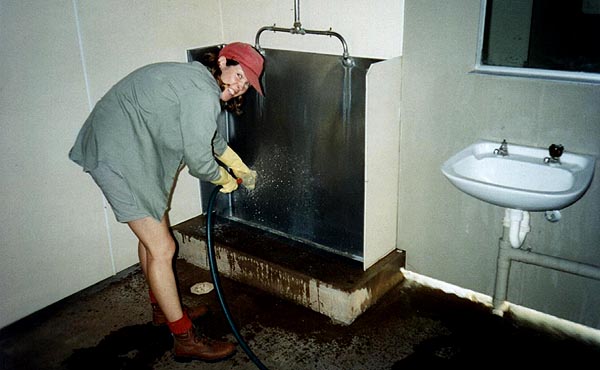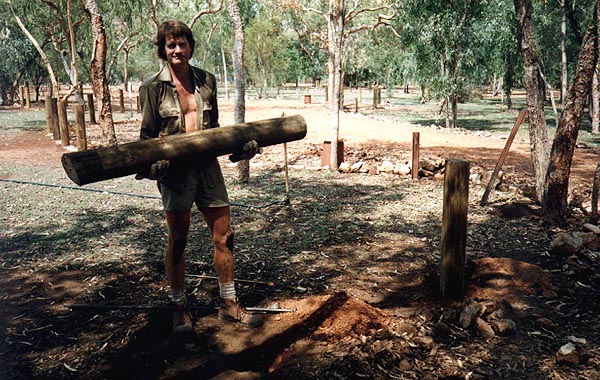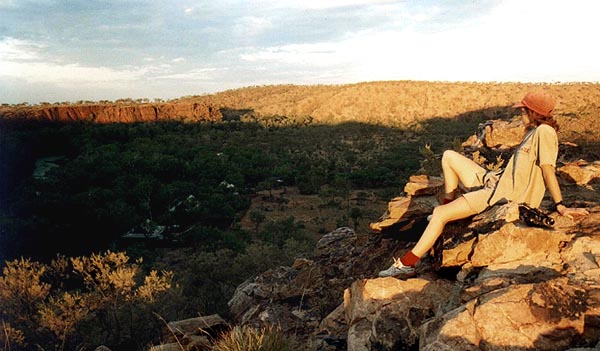|
Back at the national park, Karen and I found we were still not free of public service red tape when we attempted to update a walking track brochure. This was provided free to members of the public at the park and showed all the tracks and attractions, but due to a few inaccuracies and to changes in the roads and tracks, it was in need of updating. Karen and I spent a couple of afternoons on this project, cutting and pasting, liquid papering, and photocopying. When we had finished, Colin checked out the page and said it looked great. But we could not begin to hand it out to the public because it had not yet been approved by the district office. Their principal concern was the possibility of litigation from an injured camper because of something contained on the updated sheet. We pointed out that the old brochure was patently wrong, and much more likely to cause a member of the public to come to grief. However, the old brochure had been approved by the district office, so in the event of public injury, the department would be liable. If Colin handed out the new brochure without approval, it would be his head on the chopping block. Surely the head ranger of a remote national park should have the authority to change a walking track brochure.
We tried to put the aggravation of bureaucracy behind us and look instead at the beauty of the national park. As previously described, the park is an oasis in a vast area of dry plains, a gorge through red sandstone cliffs cut by Lawn Hill creek, which flows at four million litres an hour from springs originating in the Georgina artesian basin under the limestone Barkly Tableland of the Northern Territory. The creek is fringed by plant species left over from a rainforest which covered the area fifteen million years ago, and the park is home to some unique animal species, such as horse-shoe bats, long necked turtles, and the park's emblem, the Purple-crowned Fairy Wren, a beautiful little bird.
Because of its passage through limestone, the waters of Lawn Hill creek are highly mineralised, especially by calcium carbonate. This leaves suspension and is deposited in the form of a soft, porous rock known as tufa, most notably at falls and rapids, resulting in two features of the park, Indarri Falls and the Cascades. The deposits build up at any area of high turbulence. Unfortunately for park management, one of the most common areas of turbulence is in the park's water pipes. In ten years, some poly-pipes have been reduced from an internal diameter of two inches to only one inch, which reduces water flow by seventy five per cent. Increased pressure within the poly-pipes due to this narrowing has led to many instances of cracking, and a large amount of time is spent on plumbing maintenance.
The main attraction of Lawn Hill National Park is the gorge area. It is here on the banks of Lawn Hill Creek that the ranger station, campground and amenities are located, encompassing about sixty campsites for cars, vans and buses. A series of walking tracks leading to the features of the gorge area begins at the campground, a large expanse of well-kept lawn dotted with shady trees, parking bays, fire pits and picnic tables.
Tell-tale wet patches on this otherwise dry lawned area would signal the presence of a cracked pipe. Out would come the shovel to dig down to the pipes, the hacksaw to cut out the offending cracked section, and the joining piece to be fitted into position. It could not be slotted into the two adjacent ends of the pipe however, until their internal walls were scraped clear of the calcium carbonate build-up. Water pipe maintenance like this happened at least once a fortnight while Karen and I were at the park.
When the pump was on, which was only for the twelve hours a day when the diesel generator was on, water for showers and lawns was pumped from the creek up to a holding tank on a hill behind the campground, as well as directly to all outlets. When the pump was off, water was gravity fed from the tank. If more than half a dozen sprinklers were in use, however, the rest of the outlets received no water. I had the misfortune one night to be having a shower when the generator was turned off. There I was at the end of a long, hard day, lathered up from head to toe, when the lights went out and the water stopped. Through the bathroom window I saw John, the assistant ranger, walking by torchlight down the path leading to the campground, on his way to turn off all the sprinklers. Rather than wait until he had accomplished that task, I walked out of the shower, across to the veranda of the donga, to a hose I knew was connected directly to the pipe coming down the hill from the tank. I hosed myself down and finished my shower on the veranda. The water in the tank is about the same temperature as Lawn Hill creek itself - about twenty five degrees Celsius, so it was not exactly a cold shower. In fact, for most of our showers we did not even bother to turn on the hot water tap.
The tourist season at Lawn Hill coincides with the dry season. During this time a major ongoing task for the rangers is the watering of the campground lawns. This was one of the first jobs Karen and I were given, and one of the best jobs in the park. There was nothing better than walking up to a gushing sprinkler, grabbing it around its base and relocating it to a dry patch of grass, getting thoroughly drenched in the process. Sprinkler relocation occurred every hour and a half, for between six and ten sprinklers (depending whether the pump was on or not), twelve hours a day. All this effort barely kept the grass alive. Tourist traffic, the mineral content of the water, the scorching heat of the day, the introduction of weeds from seeds brought in on tyres and tents, and attack by hungry wallabies at night, make life difficult for the lawn at Lawn Hill.
It was a common occurrence to find half the sprinklers in the campground dribbling instead of sprinkling. The tufa which builds up inside the pipes often flakes off, lodges in the sprinkler heads and reduces the flow of water to almost zero. We always carried a set of multi-grips with us on our rounds to fix this problem as it happened. Tufa would also lodge in shower roses and completely block evaporative air-conditioners. We were grateful that the donga had refrigerative air-conditioning, especially when the temperature at night remained above thirty.
In any society, it is always the so-called lowest tasks which must never be neglected. The Prime Minister of Australia can travel overseas for a month, and nobody worries in the slightest. The country does not fall apart. Some unkind people might even say it is better off. But if the sewerage workers or the garbage collectors disappeared for a month, there would be an almighty stink. So it was at Lawn Hill. The amenities were cleaned daily, and the garbage was collected every two days, more often if necessary. Volunteer rangers were not exempt from this task either.
The cleaning of the amenities was not much fun. It is difficult to raise a great deal of enthusiasm for the scrubbing of toilets, showers and basins. I have a classic photo of Karen cleaning the men's urinal, her grin very much forced. However, it did have its moments, especially when a snake adopted the men's number one toilet as his home. Other much-loved occasional residents were the green tree frogs. I would often see a pair of muscular green legs hanging from under the rim of the toilet bowl, trying frantically to crawl back up as the water flushed around them. The frog and I would then engage in a friendly tug-of-war, a surprisingly even contest as suction and slipperiness battled against superior strength. The frogs often won, their reward being an extra day in the toilet.

Karen enjoying her work
Garbage runs could be unpleasant, especially if a camper had dumped some old meat in a bin two days before and the intervening days had seen temperatures approaching forty degrees, but they could also be a lot of fun too. Not only was there the ever-present hope of discovering some reward, like a magazine, but after throwing the rubbish from all the campground bins into the tray of a Landcruiser, separating out the aluminium cans into a box, and dumping the rest at a secluded, specially excavated site, we got to douse it with diesel fuel and set it alight. Black kites would circle overhead, riding the thermals generated by the fire, searching for rewards of their own while waiting for the flames to abate. We would then take the box of cans back to the ranger station and toss them into a purpose-built, open-ended concrete trough. Karen would drive the Toyota back and forth over the cans a couple of times, squashing them as flat as a proverbial pancake. I would then scoop them up into a large sack and toss another lot of cans into the trough for Karen to flatten.
Because of the isolation of Lawn Hill National Park, aluminium cans are the only waste product which can be recycled economically. The proceeds go to the Royal Flying Doctor Service. Other items normally recycled like glass, paper and cardboard are thrown in with the rest of the rubbish and burned. This reduces its bulk, prevents it from becoming a breeding ground for rats and blowflies, and prevents native animals from using it as an unnatural source of food.
Lawn Hill is a very young park, celebrating only its tenth birthday while Karen and I were there. It's rapid and deserved growth in popularity have placed extra demands on its infrastructure. An ongoing project upon which we spent most of our working hours, was the upgrading of the car parking bays within the camping areas. Bollards of treated pine logs were being placed around each bay to prevent cars and vans encroaching on the grassed areas. Each fifteen hundred millimetre bollard (one and a half metres) was packed into a six hundred millimetre deep hole, resulting in a nine hundred millimetre post protruding up from the ground. The national park had a wonderful post hole digger. Me.
Using a pick, a shovel and a heavy crowbar taller than myself, I would pound out a hole, down through a mixture of earth, gravel, stones and rocks. This had been river sediment, deposited and compacted over the millennia. Using an empty baked beans tin, I would kneel and reach into this hole to scoop out the rubble, a dirty, dusty, back-breaking, knee skinning bastard of a job. When the bottom of the hole was so deep that I could only reach it with a fully extended arm and my cheek resting on the ground, I would fetch a log and place it inside, pack the excavated rubble back into the hole and compact it again with the blunt end of the crowbar. When the earth was kind, this process would take about twenty minutes. When the earth was unforgiving, it could take hours. I would eventually place twenty three bollards around the campground perimeter. This may not sound like many, but at six hundred millimetres each, those twenty three bollard holes - laid end to end, one on top of the other - would form a hole almost fourteen metres deep. It would take a bollard nearly five storeys high to fill a hole that deep!

Another bollard ready to go in
All of this work was done in temperatures above thirty degrees. While I was impersonating a post hole digger, Karen was not exactly shirking the dirty work either. Flat rocks were laid into the ground between each post, projecting slightly above the surface, providing a decorative and functional border between green grass and red gravel road-surface. These rocks had to be solid, so Karen was constantly using a mattock to dig out a depression for each one, fitting it into place, testing its stability, and repeating the whole process if any wobble was detected. As each bay was completed, we would gaze in pride at our work.
The project which gave us the greatest satisfaction, however, was the construction of a gravel path, linking a parking area near a prominent track information sign to the main concrete walkway which ran the length of the campground and continued on past the ranger station. Our path was only about fifteen metres long, but ran across sloping ground, requiring a lot of soil removal, the building of a retaining wall made from rock, the collection, transportation and disposal of two tonnes of gravel, and the placement of large rocks to act as a barrier to vehicles. This project occupied a week or more, and the path received many admiring glances after it was completed. How time, the wet and a flooding Lawn Hill creek will treat it is another matter.
All the rocks for the campground came from a quarry near the dump. We would back the Landcruiser as close as we could, and lift the rocks from the ground onto the tray. The larger rocks required two people, a plank, and a lot of physical man-handling to get them onto the truck. Karen and I looked upon the heavy labouring we were doing as a workout. In Sydney, people paid hundreds of dollars for gymnasium membership in order to work out like we did.
Another activity we engaged in away from the immediate area around the ranger station and campground was track maintenance. The walking tracks at the national park lead to exceptional features and views. One leads up onto the top of the Constance Range and provides a superb outlook over the black soil plains to the south-east, and along the range towards Lawn Hill station to the north. Lawn Hill creek can also be seen exiting the park and heading off past Adel's Grove towards the Gregory River which eventually leads to the Gulf of Carpentaria. In the dry, however, Lawn Hill creek stops flowing and disappears into the plain well before it can reach the river.
Another walk leads down to the lower gorge around Island Stack, a large rock plateau completely surrounded by Lawn Hill creek in the wet. Branching off from this walk is another track which takes visitors to the Cascades, a series of tufa rapids and small pools between the middle and lower gorges. A side track climbs up onto the Island Stack plateau, where a loop track around its perimeter leads to half a dozen lookouts for views over the Cascades, and the lower and middle gorges. Access to the waters of the lower gorge is limited to protect the wildlife. From the top of the stack, Karen and I regularly spotted freshwater crocodiles basking in the sun on a log below, or swimming lazily along the creek at the bottom of the gorge cliffs in search of prey.
Other walks lead upstream, to the tufa falls at Indarri, and onto the clifftops which provide spectacular views over the middle gorge, the falls, and the ranger station and campground areas. While some of the walks are steep, all are relatively short, with the climbs onto the escarpment involving an elevation gain of about sixty metres. The longest marked walk in the park takes about three hours, but most can be done comfortably in less than an hour.

Karen on the cliffs above the ranger station
Karen and I walked these tracks often. We never tired of the scenery. Sheer red cliffs rise from the dark green water of the gorge. In some places, the creek is covered by rafts of water lilies and edged by pandanus and palms. Everywhere we walked, we performed track maintenance, replacing dislodged rocks at the edge of the paths, cutting back overhanging spears of pandanus which threatened to take out an eye, clearing away fallen palm fronds and small branches from trees beside the track. On occasions, when we found that a tree had fallen across the track, and was too large to shift, we would fetch an axe from the ranger station, and return to the site to chop out the offending section of tree trunk.
Life at the national park was mostly good. The scenery and wildlife were superb, the rangers were great, the work was interesting and most of the campers were terrific too. But life is rarely idyllic all the time - there is almost always some bad to go with the good. Forgive me for being politically incorrect, but the bad at Lawn Hill was always associated with aborigines.
|


